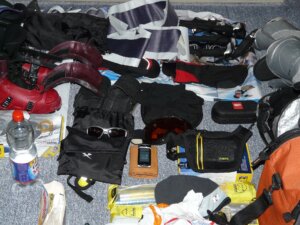Ski touring, a thrilling activity that involves traversing the backcountry, demands a unique set of gear and equipment. This sport enables skiers to clamber uphill using specially crafted equipment, adding a sense of adventure unreachable within a regular skiing resort. Upon reaching the chosen summit, the gear can be switched to function as regular downhill skis, enabling the skiers to cherish fresh, untouched lines on their descent.
The exhilaration of ski touring isn’t without challenges, as it requires breaking the norms of typical resort skiing gear. While some downhill skis can serve as touring skis, the bindings and boots required for this adventure are unique and designed specifically for touring. Additionally, skins are needed for the skis’ underside to manage the uphill glide.
Equipping oneself rightly is crucial not just for a successful skiing experience but also for ensuring safety. The ski touring equipment list is exhaustive, considering the requirements, including essentials such as skis and boots, preferred clothing tailored to the demanding backcountry skiing conditions, and critical avalanche safety tools.
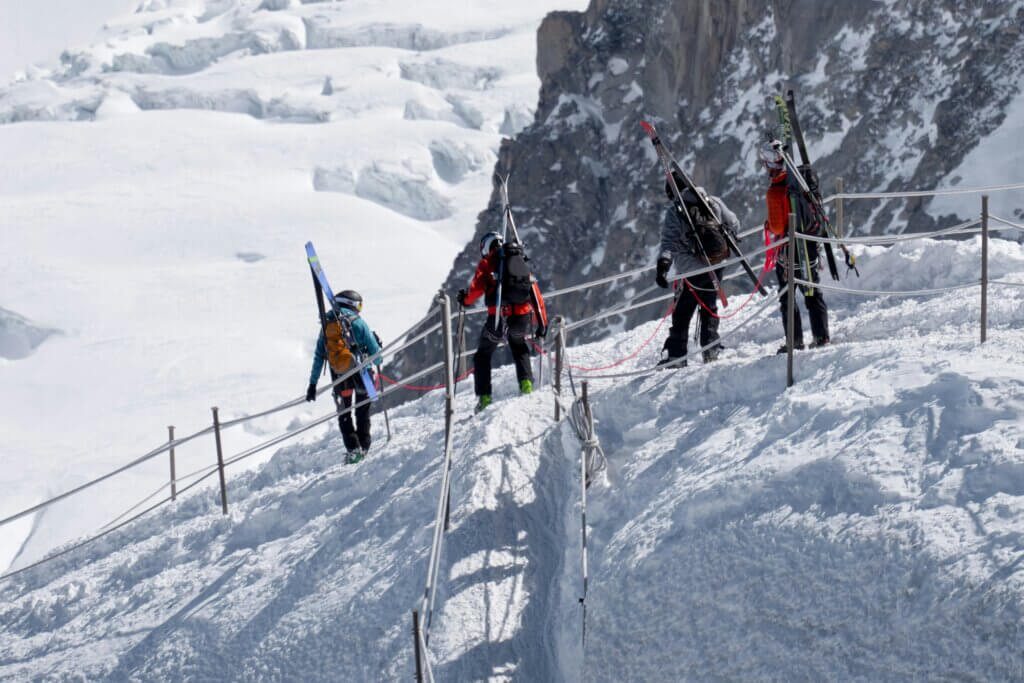
One crucial part of the ensemble that shouldn’t be disregarded is the necessity of an avalanche safety-compatible backpack. This carries immense importance due to the inherent risk factors faced while ski touring in the heart of the backcountry.
Another handy item for ski touring would be adjustable poles with powder baskets. These aid in maintaining balance, and the adjustability makes them versatile for different terrain and skiing styles.
Skiers interested in touring should undertake an in-depth understanding and get some practice before venturing into the backcountry. It’s also recommended to be thoroughly versed in avalanche safety training and to be accompanied by a guide until one feels entirely comfortable in the unfamiliar terrain.
A ski touring adventure’s success, safety, and enjoyment hinge heavily on having the right gear. Therefore, be sure to check detailed product round-ups and consult professional skiing gear reviews to make an informed purchase decision.
Guide to Ski Touring Equipment Essentials
Choosing the Right Touring Skis
The right equipment becomes paramount for an enjoyable experience when embarking on a ski touring adventure. This includes selecting the ideal pair of skis that perform efficiently for ascending and descending mountain terrains. Lighter and skinnier ski designs generally prove to be more effective for uphill tracks, offering a high degree of efficiency, while models that are heavier and broader provide increased stability and improved flotation for downhill rides through thick layers of snow.
Choosing the appropriate touring skis requires a considerate balance between a construct light enough for uphill hikes and sturdy enough to handle variable skiing conditions. Some ski touring enthusiasts prefer a slightly shorter ski to minimize the overall weight of their gear. However, the selection process can be overwhelming due to the extensive range of models and styles available on the market. This variety ranges widely from beginner-friendly backcountry skis to advanced models specifically designed for seasoned ski tourers seeking an upgrade in their equipment.
Choosing the Right Ski Touring Boots
Selecting the optimal ski boots is an integral step in ensuring warmth and comfort throughout the day on the slopes. The best choice in backcountry boots hinges on the skier’s style, preferred terrain, and fit. It is especially necessary to find the perfect fit for ski boots. For devotees of ski mountaineering, boots with ample cuff rotation and less weight are preferable. On the other hand, downhill skiers should lean towards boots with a rigid construction and more robust design for enhanced support.
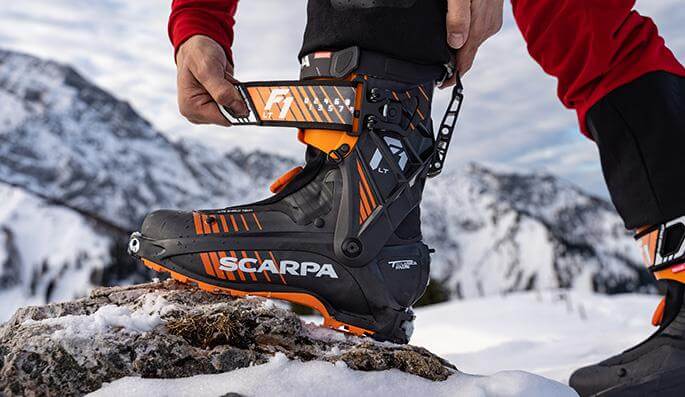
Particularly designed for ski touring, these boots offer a ‘walk mode’ and increased flexibility, aiding in easier uphill movement. Built lighter and breathable than your average resort-bound boots, touring boots yield superior comfort. Certain touring-specific styles feature a simple one or two-buckle fit, removing the hassles of complicated fastenings. The market offers an impressive range of styles for ski touring boots, including those that blend features of resort and touring boots and boots specifically tailored for ski touring.
Bindings
Ski touring requires the right pair of skis and the relevant bindings that bring forth unrivalled agility and efficacy when covering uphill distances. Alpine touring bindings, more commonly known as “tech” bindings, are the essence of a ski touring setup owing to their crucial role in uphill mobility. They comprise a toe piece flanked by two pins that securely link with tech-compatible ski boots and a detachable heel.
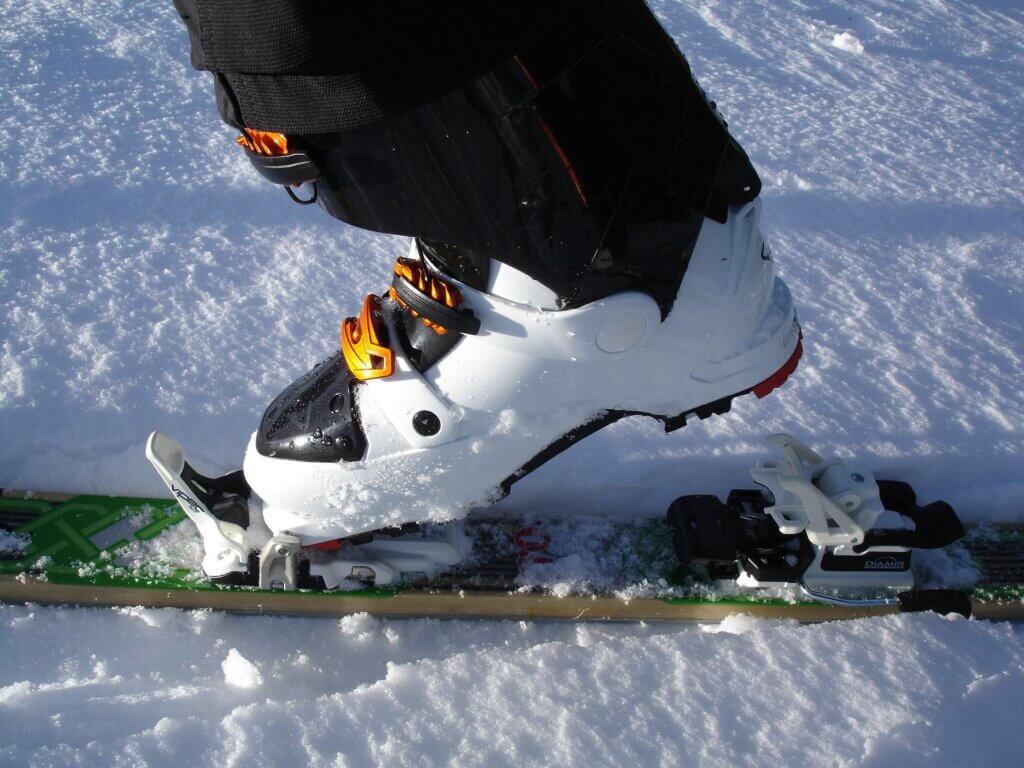
These particular characteristics of touring-specific bindings make the uphill glide possible by allowing the skier to unhinge their heel. Skiers have a myriad of options at their disposal when it comes to choosing binding types. From the lightweight pin binders that offer minimalistic design and optimal touring capabilities to the robust resort-friendly frame bindings designed for all-around use, skiers are spoiled for choice in how they equip their gear for their touring expeditions.
Fundamentally, every touring-specific binding allows skiers to experience the unique exhilaration of the uphill glide seamlessly.
Ski Poles
Ski touring equipment is essential for individuals venturing into the backcountry. One such piece of gear is the ski pole, which is a valuable aid, particularly for challenging terrains. It provides much-needed balance for executing downhill turns and, potentially, more importantly, contributes to powering ascents of steep inclines – a benefit of distinct value when skinning.
For anyone exploring the backcountry regions, the choice of ski poles significantly leans towards adjustable varieties. The convenience of altering the poles’ length during side-hilling or boot-packing activities ensures that these adjustable poles stand as a preferred choice for many backcountry explorers. The ability to shorten or lengthen the poles as per the changing topography, thereby maximizing efficiency and convenience, justifies this preference.
Choosing the Right Climbing Skins for Ski Touring
Climbing skins are specially designed accessories that fasten to the bottom of your skis, enabling uphill movement without the risk of sliding back downhill. The implementation of this ingenious tool is uncomplicated: adhesive on the reverse side of the skin clings to the ski base, while the side in contact with snow provides unidirectional friction.

Skins are also available in different materials, typically nylon or mohair. A skier might opt for nylon skins with enhanced traction, facilitating advanced climbing. Alternatively, mohair offers heightened glide, making it an apt choice for skiers seeking streamlined movement.
It is important to note that skins require customization in terms of both width and length to suit the skis. In essence, they should only expose the edges at the waist of the skis. Despite this customization requirement, modern climbing skins can sometimes be procured pre-cut, designed specifically to match certain skis.
While cutting skins may seem daunting, it can become an enjoyable DIY project for those with a knack for precision and patience. Detailed instructions and necessary tools are included with every pair of climbing skins. However, if DIY projects are not your staple, turning to a ski shop technician to get the skins cut is a quick and effective alternative.
Eye Protection
Suitable eye protection is indispensable as the surface of the snow acts as a large-scale reflector of light. This is the case whether the conditions are under a gleaming sun or shrouded in clouds. A high-quality pair of sunglasses or glacier glasses promises to safeguard your eyes, shielding them from snow blindness, excess squinting, and even the harsh effect of wind burn.
Unlike goggles, these devices remain impervious to fogging during a skin track trek. Also, they are highly recommended for skiing downhill. However, carrying a pair of goggles in one’s pack for extremely cold conditions, instances of heavy precipitation, or while navigating deep powder is advisable. Therefore, the choice of eye protection in ski touring equipment significantly depends on the nature of the weather and terrain conditions on the ski day.
Eye protection in ski touring is thus a multipurpose tool: it ensures a clear vision pathway for the skier and engages in a constant battle with harsh external elements to keep the eyes comfortable and healthy. Despite their simplicity, these often overlooked elements are fundamental when preparing for a day of ski touring.
Ski Touring Helmet for Safety and Comfort
Despite their previously sporadic use during backcountry expeditions, ski helmets have become increasingly prevalent today, with a wealth of lightweight options readily available in the modern market. Their use is particularly recommended during downhill skiing for added safety measures. While a conventional resort helmet can serve as a viable substitute during ski touring, investing in a designated helmet is highly advisable for those planning regular excursions.
Compared to their resort counterparts, touring ski helmets boast a more lightweight design that eases the strain on the skier during their journey. Furthermore, these specially designed helmets incorporate a generous number of vents. This feature ensures a constant and free airflow, providing the wearer with optimal comfort and breathability even during a strenuous ascent or descent. Clearly, not only do these helmets ensure optimal safety, but they also significantly enhance the overall skiing experience.
Choosing the Right Backpack
When embarking on backcountry skiing, the importance of possessing robust, specially designed gear cannot be overstated. Paramount among these is a good, well-fitted ski backpack capable of storing all the essential tools required. These backpacks are engineered with a unique design that includes a distinct tool compartment intended for the organization of avalanche equipment. Such backpacks usually come with dedicated pockets specifically for accommodating a probe and shovel, thus facilitating quick and easy access to gear during emergencies. For day tours, a backpack with a capacity between 25 and 35 litres should suffice.
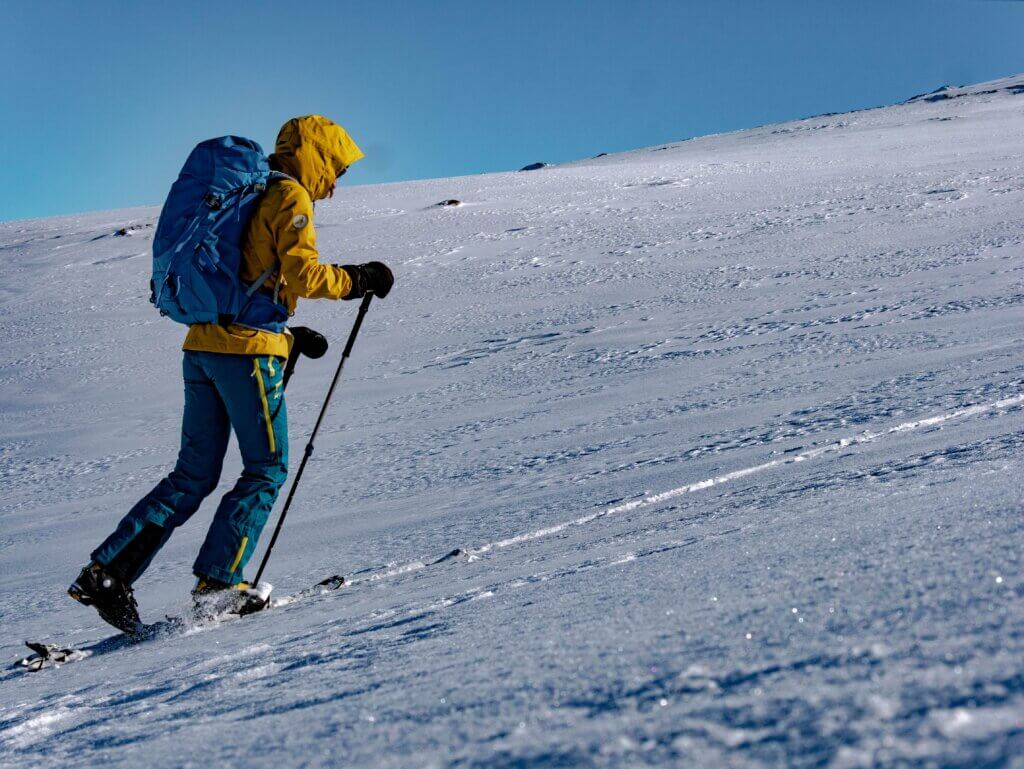
The backpack should ideally be low-profile and lightweight, ensuring it doesn’t interfere with the skiing experience. It should also come equipped with diverse pockets to accommodate various pieces of safety equipment.
In recent years, ski backpacks with built-in avalanche airbags have been gaining popularity, offering increased survival chances if caught in a slide. This feature works similarly to a parachute deploying during skydiving— the airbags remain packed within the bag until deployed via a conveniently located trigger. Upon activation, the airbag inflates either by an electric fan or a compressed air cartridge.
Even though the former type is more costly, this model can be easily recharged and triggered multiple times per charge. In comparison, the latter type requires a refill after each use. The inflated airbag plays a critical role in enhancing an individual’s surface area, which aids in keeping them atop the avalanche debris. Moreover, it provides essential protection to the head and neck, reducing trauma during a fall.
Essential Clothing Items for Backcountry Ski Touring
Choosing the Ideal Backcountry Ski Jacket: Hardshell vs. Softshell Options
When considering ski touring equipment, the ideal ski jacket varies significantly based on the prevailing temperature, conditions such as wind and precipitation, and the day’s activity level. Indeed, many serious skiers maintain a selection of jackets to accommodate different instances. Typically, backcountry ski jackets, preferred for ski touring, are more lightweight and streamlined than jackets designed specifically for resort use.
They come in two varieties: hardshell and softshell. Hardshell jackets offer superior protection from environmental factors, while softshell jackets tend to offer more breathability.
Choosing the Right Ski Touring Trousers or Bibs
When it comes to ski touring, it is important to consider the function and structure of the clothing worn. Traditional ski pants, often favoured by resort skiers for their insulated and waterproof qualities, are great for keeping warm while seated on the chairlift. However, these types of pants can quickly cause overheating when venturing into the backcountry, particularly on the skin track.
Instead, the recommended option for ski touring includes non-insulated, waterproof hardshell pants or softshell pants with a water-resistant coating. These pants are equipped with zippered vents that enable the wearer to discard excess heat as needed. This design allows for increased thermal regulation, enhancing the tour’s comfort.
Furthermore, the features of the pants or bibs purchased for ski touring should be considered. A dedicated pocket for an avalanche beacon, complete with a zip closure and an internal clip or lanyard, is worth considering. Additionally, wide or expandable leg openings that accommodate ski boots in walk mode offer added convenience and flexibility.
For women, ski bibs with a rear or side panel capable of unzipping or opening easily are highly recommended. These make restroom breaks quick and hassle-free in the great outdoors. These characteristics, thankfully, are becoming increasingly standard in the design of modern ski bibs and pants, making suitable options readily available for ski touring enthusiasts.
Choosing the Right Gloves for Ski Touring: Balancing Comfort and Safety
Necessity dictates that your resort glove may serve dual purposes and also function as your downhill glove. However, bear in mind the paramount importance of these gloves being fully waterproof, considering the lack of indoor facilities for warming up chilly digits. For unpredictable weather and the extreme cold of snow-filled days, opt for gloves that offer maximum protection, preferably those with a gauntlet.
It is further suggested that keeping multiple pairs of gloves at hand while skiing in the backcountry can be beneficial. During instances of high-intensity activity such as trail-blazing or fine-tuning ski boot buckles, a lighter, breathable liner glove offering enhanced dexterity can be more comfortable and practical.
Lastly, it makes good sense to carry an additional pair of warm gloves or mitts in your pack. They occupy minimal space, but they significantly boost your safety preparations should you find yourself stranded and in need of rescue or obliged to spend an unexpected night in an emergency shelter. Thus, in a possibly precarious situation, these backup gloves might prove invaluable.
Choosing the Right Baselayers for Ski Touring
An essential component of your ski touring equipment is your next-to-skin layer, which serves a dual purpose – insulation as well as moisture wicking when you perspire. Most often, this layer is made up of odour-resistant merino wool, long-lasting polyester, or a blend of wool and synthetic materials. The goal of this blend is to integrate the best characteristics of both these materials seamlessly.
During colder conditions, specifically when temperatures plunge into the teens or even lower, opting for midweight baselayers on both top and bottom is most advisable. Last but not least, on relatively warmer days, lightweight options are highly recommended. These choices facilitate adjustment to diverse weather conditions, ensuring the ski touring experience is comfortable and enjoyable.
Understanding the Importance of a Mid-layer in Ski Touring Equipment
Ski touring equipment typically uses a three-tiered clothing system for optimal protection and warmth: the shell, midlayer, and baselayer.
Of these, the mid-layer is of utmost importance as it functions as the main insulator, enclosing warmth near the body. Midlayers are outfitted for use across a range of activities, including those requiring high exertion, such as skinning. This implies that beyond merely providing insulation, mid-layers must also be designed to ensure breathability. To fulfil this critical role effectively, ski touring mid-layer garments need to resist harsh weather elements such as wind, snow, and sleet, ensuring sustained performance irrespective of prevailing outdoor conditions. Thus, the mid-layer can be seen as the versatile workhorse of the ski touring clothing system.
Choosing the Right Down Jacket for Ski Touring
Ski touring equipment needs to provide warmth during transitions or rest periods, such as snack breaks while maintaining the heat generated from uphill movement. One optimal strategy entails wearing a mid-to-heavyweight down jacket. Foremost, down jackets offer superior warmth and weight features compared to their synthetic insulated counterparts. Furthermore, the severity of warmth needed from a jacket will be reliant on several factors.
Essentially, these include the conditions of the environment and the duration of exposure. For instance, day trippers might find a midweight down jacket sufficient. On the other hand, those venturing out for overnight or multi-day tours will likely benefit from a heavyweight parka. With appropriate ski touring equipment, one can ensure delightful experiences sans compromising comfort.
Essential Headwear and Ski Socks for Backcountry Skiing
An Overview of Ski Socks for Ski Touring
Ski touring requires specialized equipment, amongst which are ski socks, which play a crucial role in comfort and functionality. Unlike hiking socks, ski socks are designed to sit higher on the calf, providing optimal comfort and fit within ski boots. The modern designs are thin and lightweight, essentially shifting the responsibility of warmth to the bootliner.
Ski socks are expertly designed to incorporate padding in areas that are vulnerable to friction, such as the shins and toes. Consequently, the overall comfort and protection against rubbing are elevated, enhancing the skiing experience.
One common recommendation for ski sock materials is the Merino wool blend. This combination is remarkably soft and luxurious to the touch, lending a comfortable feel to the wearer. Furthermore, the merino wool blend possesses the ability to effectively combat odours, contributing to its popularity. Adding to its many conveniences, this material is known for its high durability, too, making it a reliable option for ski touring activities.
Choosing the Right Headgear for Ski Touring
Ski touring requires a careful selection of equipment, particularly when it comes to headwear, considering the body’s propensity to lose a significant amount of heat through the head. Ensuring appropriate head coverage is thus paramount, especially during cold periods.
For backcountry skiing, a preference is often for lightweight articles such as a beanie, buff, or a hat with a brim for the skin track. These are not overly burdensome and provide the necessary warmth for the head. Yet, transitions and descents call for something a little warmer, such as a snug beanie.
Notably, the choice of headwear also depends on the climatic conditions. Even while wearing an insulated helmet during the downhill, the utility of a second, comfortable beanie cannot be overemphasized. This acts as an essential backup, providing warmth in case your primary beanie gets bogged down by sweat.
In contrast, sunny days operating under clear blue skies call for a different approach. A brimmed cap or a trucker hat is advisable for such occasions, as it offers the added benefit of shade. Thus, planning for different conditions and having appropriate headgear can make ski touring a more comfortable experience.
Essential Avalanche Safety Equipment for Backcountry Ski Touring
Ski touring necessitates a variety of equipment, but paramount among these items is the requisite avalanche safety gear. When embarking on an adventure in the backcountry, where avalanche risks are managed by the individual rather than through professional control methods used by ski resorts, having the correct safety gear is crucial.
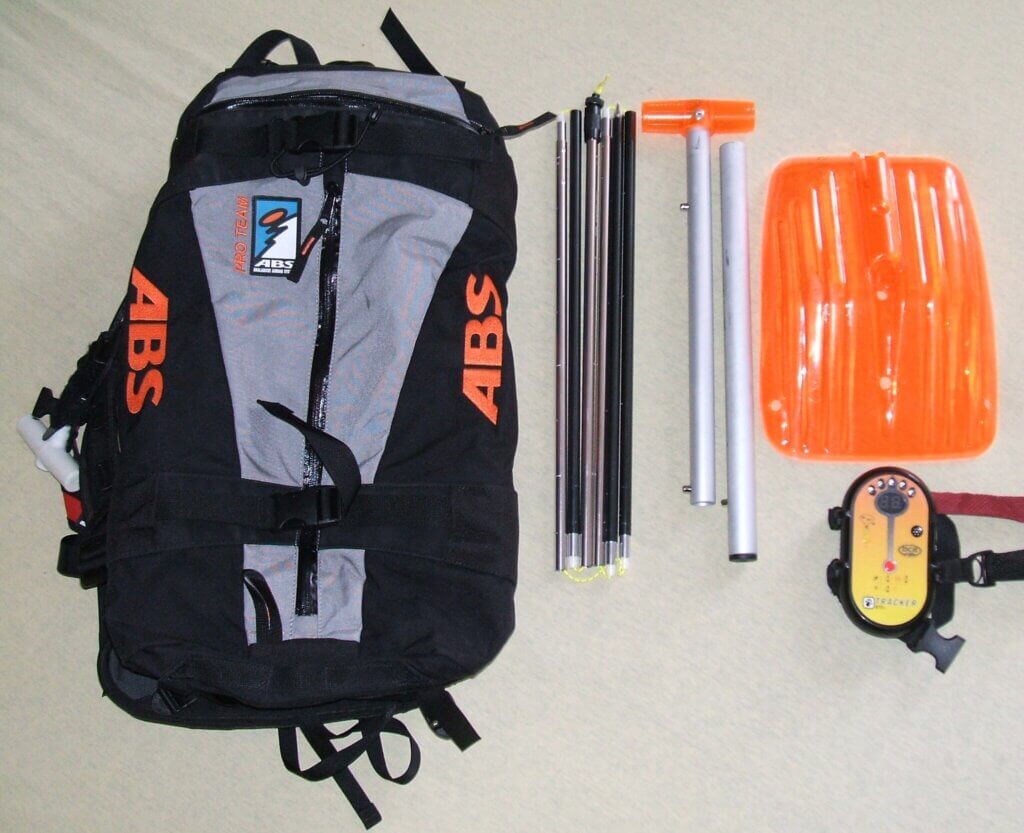
The absence of a professional team using bombing, ski-cutting techniques, or the practice of closing off unmanageable terrain means responsibility for managing risk is transferred to the individual skier. It is in such circumstances that the presence of a transceiver, shovel, and probe in every skier’s gear collection becomes essential.
Those planning to enjoy the thrilling landscapes offered by backcountry locales must invest in and always carry the aforementioned avalanche safety equipment for not only assessing snow conditions but also for assisting others safely in case of an unfortunate mishap. Although the focus in this section is on the necessary equipment, it is equally important to remember that complementing this with appropriate avalanche safety education is key for a holistic approach to safeguarding oneself and others on the slopes.
Importance of Avalanche Beacons in Ski Touring
A beacon, commonly referred to as a transceiver, is an essential piece of ski touring equipment to garner attention or locate someone in the event of an avalanche. Avalanche debris can obscure the location of buried skiers, a scenario where a beacon may prove invaluable. However, like all safety gear, a beacon’s value lies not just in its possession but also in the user’s ability to operate it effectively. Continual practice and familiarization with this tool are highly recommended to ensure that usability skills remain honed.
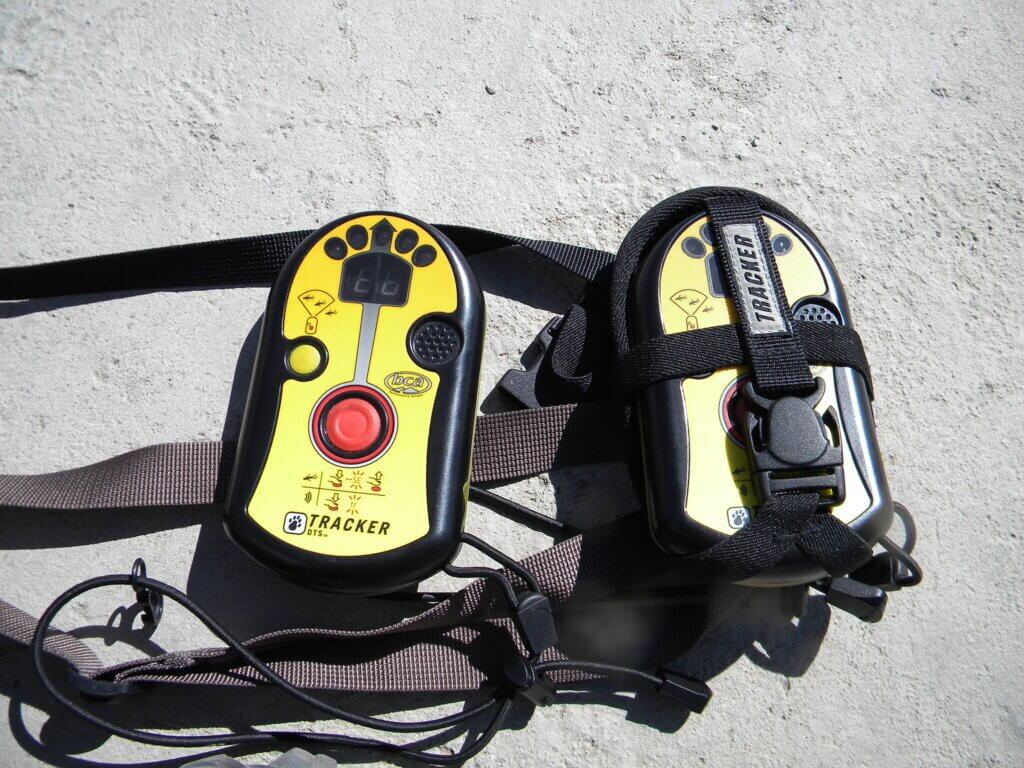
Furthermore, proficiency in beacon usage not only benefits the individual skier but also extends to their skiing partners. An adept use of beacons by an entire party considerably enhances the chances of saving lives during an avalanche incident. Ensuring everyone is trained in using these life-saving devices should be regarded as a paramount priority in ski touring.
Your Probe for Safety and Measurement
Ski touring equipment is fundamental to ensuring safety on the slopes, particularly if traversing through areas prone to avalanches. One of the key pieces of gear in this regard is the Avalanche Beacon. This crucial tool aids in discerning the location of an individual under a pile of snow.
Once the Beacon has given an indication of a person’s location, the responsibility then falls on the Probe, another vital piece of ski touring equipment. The probe is used to verify the person’s position and determine the depth of burial. Utilizing a systematic approach upon gaining a strike from the probe is highly recommended. It’s then crucial to keep the probe stationary in the located position.
The next course of action involves using a shovel to commence digging. The interrelation of the beacon, probe, and shovel illustrates the interplay between different pieces of ski touring equipment.
Beyond the context of an avalanche, probes serve a more versatile purpose. They prove especially handy for quantifying the overall snow depth or characterising the dimensions of a data pit. This multifunctional utility of the probe underscores its importance within the array of ski touring equipment.
Choosing the Right Avalanche Shovel for Your Ski Touring Kit
Ski touring equipment often includes an avalanche shovel, as it is a paramount piece of safety gear. This tool serves a dual purpose in ensuring skier safety. It is primarily used in recovery efforts for extracting victims of avalanches. Simultaneously, the shovel is useful in creating snow-study pits, which provide pivotal data about the snowpack.
The versatility of the avalanche shovel extends beyond safety measures and finds exceptional use in the wilderness during extended winter expeditions. This indispensable tool is instrumental in building snow kitchens and setting up tent sites, among other amenities. For a broader understanding of its extensive applications, one might refer to a comprehensive winter camping checklist.
While selecting an avalanche shovel, it is crucial to ensure that it is resilient enough to penetrate rock-hard layers of snow. Yet, it is equally important that it retains a light frame and collapsible structure, allowing it to fit comfortably into a standard ski backpack. This combination of toughness and portability makes it an invaluable addition to any ski touring equipment set.
Ski Touring Essentials: Extra Gear for Ultimate Safety and Convenience
Ski Touring Equipment: Choosing the Right Navigation Tools for Winter Backcountry
Navigating wintry backcountry landscapes safely relies on understanding and accurately interpreting the terrain. To aid in this, a topographical map is beneficial for maintaining an appropriate course and ensuring a safe return to the parked vehicle. Given the likelihood that cold temperatures will rapidly deplete a phone’s battery, keeping it close to your body is advisable, optimizing its durability. However, it should be kept at least 30cm from an avalanche beacon.
For those desiring a more durable solution, a handheld GPS device is a viable alternative, having been specifically designed to withstand the harsh conditions of outdoor use. Though more time-consuming, the traditional method of using a paper map and compass are dependable tools for those well-versed in backcountry navigation. Overall, having proper navigation tools is vital to ski touring equipment and preparing for backcountry explorations.
Essential First Aid and Repair Kits for Ski Touring’
Winter touring demands you venture far off the beaten path; as a result, medical care is often hours away. This makes including a first aid kit in your ski touring equipment crucial to mitigating any risk of an incident escalating. Basic supplies such as bandages, gauze, tape and pain medicine should be supplemented with winter-specific items like hand warmers, lip salve, and mini sunscreen bottles.
Crafting a tailored winter first aid kit does not merely hedge against the threat of physical injury but also the naturally harsh environmental conditions. Moreover, should your ski touring occur in particularly remote regions, rescue apparatus such as a sledge, tarp, or contrivance supplies should be considered. Adding a satellite device such as Garmin’s InReach equips you to summon help when necessary – refer to the communication devices section for deeper insight on this topic.
Addressing non-medical threats, a ski repair kit would be another commendable addition to your ski touring gear. This aids in problem-solving for issues arising with ski skins, bindings or any other apparatus. The compact nature of spare tail clips, powder baskets for poles, ski straps, duct tape, skin adhesive, fabric tape, short cords and wire allows them to occupy minimal space, yet their potential utility for rectifying gear malfunctions is significant. Further enhancing the kit, a small hardware hose clamp can cleverly bind a fractured ski pole temporarily.
These additions to your ski touring gear work collaboratively to ensure a safe, smooth journey across the snow-clad terrain.
Importance of Having a Headlamp in Ski Touring Equipment
Ski touring equipment plays a vital role when venturing out onto the backcountry. Predominantly, this form of skiing takes place during daylight hours, yet the capricious winter weather and shorter days can extend your return beyond sunset. Hence, carrying a headlamp with you proves to be crucial. The potential of an unexpectedly prolonged afternoon run should not be underestimated.

In addition, temperature is another key consideration to bear in mind. In harsh, chilling weather, batteries are susceptible to premature exhaustion. Subsequently, a practical suggestion is to stow your headlamp in a pocket close to your body, thus utilizing your body’s warmth to sustain the batteries’ energy, particularly during colder weather. This simple action can significantly contribute to battery longevity, ensuring the headlamp performs effectively when needed.
Essential Snack Recommendations for Ski Touring
Venturing out on a ski tour demands ample preparation, particularly when it comes to provisions. Packing an abundance of energy-rich food is crucial as the body naturally expends more energy in cold conditions, with additional demands placed by the physicality of skinning. As a much more active endeavour than simply riding on a chairlift, ski touring can exhaust your energy reserves quickly.
Nutritious bars are an excellent choice, offering both convenience and a favourable calorie-to-weight ratio, making them a staple in many ski touring packs. They are compact and lightweight yet packed with nutrients, thus being ideal for such a high-intensity sport. Additionally, considering the cold conditions synonymous with this sport, packing a thermos of hot soup can function as an effective tool for both insulation and nutrition.
The portable luxury of a sizeable sandwich also makes for an appetizing mid-trip snack, contributing towards keeping energy levels stable throughout the day. Typically, most ski touring enthusiasts find that by day’s end, they’ve devoured their packed provisions with little to no leftovers. Therefore, it is of paramount importance to bring an adequate amount of high-energy food whilst ski touring to ensure a fulfilling and energizing experience.
Choosing the Right Water Bottles for Ski Touring
Ski touring in the mountains demands a unique set of equipment due to the restrictions presented by snow-laden landscapes. One such piece of essential gear for backcountry skiers is a reliable water source, which cannot essentially be refilled from frozen streams or lakes, unlike in backpacking. Therefore, carrying a sufficient amount of water, typically around two litres, becomes of utmost importance for a whole day’s skiing tour.
To facilitate easy hydration, a water bladder attached to a hose is a favoured option among many skiers. This alternative allows effortless drinking even while rapidly sliding downhill. However, it is critical to note that to prevent the water from freezing, the bladder and hose should be insulated and ideally tailored for winter use.
For ski tours that extend over longer durations or for those who necessitate more hydration, carrying a lightweight backpacking stove could be considered. This practical gear can prove useful for melting snow, acting as a ready and available water supply. With these specific considerations in mind, backcountry skiers can best manage their hydration needs in the often challenging, icy wilderness.
Choosing The Right Camera for Your Ski Touring Adventures
Ski touring presents the perfect opportunity to indulge in the breathtaking beauty of snow-clad landscapes. The enchanting glow from the snow, mixed with the serenity of winter, can create an absolutely mesmeric environment – a truly divine stage for the photographer’s canvas. The choice of camera to capture these moments, however, tends to be a query for many.
While professional-grade cameras do come with a hefty price tag and are heavier, they undoubtedly offer a superior photographic experience. The intricate details they capture, the richness of the colours, and the depth they bring to the images are incomparable to the results from basic point-and-shoot cameras or even smartphones.
However, it is imperative to note that excellent ski touring photography does not rely solely on the equipment used. Despite the high-end technology and significant advantages of professional cameras, it is the photographer’s skill that truly brings a photograph to life. Therefore, while premium equipment does aid in producing great pictures, it does not necessarily guarantee them.
In conclusion, selecting the appropriate equipment for ski touring largely depends on your specific requirements and desired outcomes. Although expensive and relatively heavy, professional cameras triumph in quality and detail to bring forth captivating and dynamic images of your winter adventure.
Additional Accessories for a Successful Ski Touring Adventure
When embarking on a ski touring adventure, it’s vital to be well-equipped beyond just the fundamental gear. Additional equipment can enhance comfort, safety, and enjoyment during the excursion.
Key items worth considering include sunscreen and lip balm, both of which are essential for skin protection from harmful UV rays or windburn. Disposable hand warmers are another valuable accessory, providing essential warmth in cold conditions.
A whistle can attract attention or signal for help if needed for personal safety measures. And if you intend to venture onto firm terrains, ski crampons are highly recommended. For more challenging landscapes, consider carrying boot crampons and an ice axe.
Another useful tool is an inclinometer, which is used for measuring slopes, assisting with navigation, and potentially avalanche risk assessment. A compass is also vital for providing a reliable sense of direction.
A snow study kit can be beneficial for the science-minded or the safety-conscious. This typically includes a thermometer, slope, polycarbonate crystal card, and meter, each designed to understand the snow’s conditions and potential risks thoroughly.
In the case of emergency situations, having a shelter or blanket at hand can be lifesaving. Face and neck protection like a Balaclava or neck gaiter is recommended for extreme cold.
Lastly, practical items such as a knife or a multi-tool envelope should also be packed. These are versatile items that can serve multiple purposes, from food preparation to gear repair.
The need for each item might depend on the specifics of your journey and goals for the day. However, when venturing miles from the trailhead, especially during massive winter outings, most of these items are generally handy to have within easy reach.

